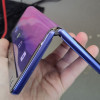Hands On with the Huawei P1 S
Jan 9, 2012, 5:15 PM by Rich Brome @richbrome

We spent a few moments with the new world's thinnest phone, the Huawei P1 S. Although it's a global announcement, an LTE/CDMA version is promised, practically assuring a US release. Read on for our impressions.
Article
The Huawei Ascend P1 S is the new thinnest smartphone in the world, at 6.68 mm, beating the Motorola Droid RAZR's 7.1 mm by (almost literally) a hair.
The version announced today at CES is officially a WCDMA/GSM phone, but we were told by James Jiang, Executive Vice President for Product & Marketing USA, that an LTE version is also in the works. An LTE/CDMA version, specifically. That indicates to us that the P1 may come to MetroPCS or Cricket - or both - as both carriers have strong relationships with Huawei.
There are actually two P1 models: the P1 S and the plain ol' P1. The P1 S is the world's thinnest. The P1 is a tad thicker... technically. But I couldn't notice any difference in thickness in person. I stared at them side-by-side, held them... they seemed equally thin to me.
The specs are even identical between the two, aside from that thickness number. So why even make the P1? I suspect it's a bait-and-switch of sorts. Whatever makes the "S" version thin enough to claim the world title may not be commercially viable. We may end up seeing the P1 on the market, not the thinner P1 S. I, for one, wouldn't care as a consumer. Huawei may be playing games in order to get bragging rights and headlines, but the P1 is still one darn thin, light phone.
The specs of the P1 are fairly high-end. The processor clocks in at 1.5 GHz, on two cores, naturally. The screen is 4.3-inch Super AMOLED, protected by Gorilla Glass. The camera is 8-megapixel. In other words, it's direct competition for the Droid RAZR.
The feel of the phone is mostly nice. It's all plastic and feels like it. Somehow it manages to feel both lightweight and solid, like it was carved from a solid block of plastic. The surfaces are all glossy, which attracts fingerprints like mad. The shape is rounded away from the front at the top and bottom, in a way that reminds me of a Samsung Captivate or a BlackBerry Curve. The back looks more like a Samsung Galaxy S II. It's a handsome enough design.
The GSM/WCDMA version is a true world phone. Even if it never goes on sale in the US, you might consider importing one, as its penta-band WCDMA/HSPA will support both AT&T and T-Mobile's 3G networks.
The Huawei will run Android 4.0 from day one. Playing with it, we noticed some minor tweaks to the camera interface, but most of the interface looked stock. One curious feature is that the home screens and app/widget menu support landscape mode, something Android 4.0 doesn't support on a Galaxy Nexus. Interesting.



















 TCL's New Foldable Concept Swings Both Ways
TCL's New Foldable Concept Swings Both Ways
 Hands On with the Motorola moto g stylus 5G (2022)
Hands On with the Motorola moto g stylus 5G (2022)
 Hands On with the TCL Stylus 5G
Hands On with the TCL Stylus 5G
 Hands On with the T-Mobile REVVL 6 Pro 5G
Hands On with the T-Mobile REVVL 6 Pro 5G
 Hands On with Xplora Kids Smartwatches
Hands On with Xplora Kids Smartwatches



